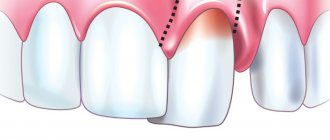Improper and irregular oral care means there is a high probability of getting some kind of infection, which can lead to gum disease. Gum papilloma is a form of oral disease that requires immediate treatment. It may also occur on the lips, tongue, larynx, and throat. Papillomas can be quite painful, and their development threatens inflammatory processes in the oral cavity.
Why do vaginal papillomas occur?
The main cause of papilloma in the vagina is the papilloma virus. It enters the body through unprotected sexual contact with a carrier. However, there are a number of factors that increase the likelihood of infection. These include sexually transmitted diseases (for example, gonorrhea and chlamydia).
Also, the reasons that contribute to the development of papillomas are:
- frequent change of sexual partners;
- disruption of the normal vaginal microflora (dysbiosis);
- low immunity;
- inflammation of the ovaries;
- severe stressful situations;
- pregnancy;
- deviations from the endocrine system;
- lack of vitamins in the body.
If several of the reasons described above are present, the risk of infection increases significantly. The incubation period is no more than 3 months, but under the influence of unfavorable circumstances for the immune system, this time can be reduced to 14-20 days.
Clinical manifestations of warts on the lip
A wart on the lip does not appear the next day after the papilloma virus enters the body.
The incubation period can last from six months to several years.
This often occurs when the immune system malfunctions.
Having penetrated the skin or mucous membrane, the virus integrates its genetic material into human cells and thus begins to multiply.
As a result, characteristic neoplasms appear at the site of virus introduction.
The pathogen provokes warty growths, disrupting the processes of keratinization of the skin.
Oncogenic strains of papillomavirus change the genetic apparatus of cells in such a way that a malignant formation is formed.
What do condylomas look like?
The formation of growths in the intimate area is a common reason for girls to make an appointment with a gynecologist. Papillomas on the labia are small white growths. Vaginal papillomas can be of 2 types: exophytic and endophytic. The former are characterized by a papillary surface and a pointed shape; they are localized in the superficial layer. As a rule, they are provoked by HPV with a fairly low level of oncogenic activity. The latter are flat, they usually grow deep into the epithelial tissue and can cause pathologies in healthy tissue.
If such condylomas are not treated in time, the risk of developing cancer increases.
Symptoms of vaginal papilloma
The virus infection scheme is as follows: first, the pathogen enters the dermis layer, affecting the membrane of healthy cells, then the infected DNA is introduced into the cell, after which the virus waits for favorable conditions for activation. In this situation, if the infected girl has a strong immune system, papillomas in the vagina may not form for a long time. In total, there are 3 stages of the disease. The first is characterized by the absence of pronounced symptoms. Depending on the general physical condition and the state of the immune system, this stage can occur over a long period of time, and in the absence of provoking causes, symptoms may not appear for several years. Despite this, the girl is already a carrier of the virus and can infect her sexual partner.
The second stage is characterized by changes in the mucous membrane of the genital organs. Neoplasms can be localized deep in the vagina, so it is not possible to identify them independently. Papillomas at the entrance to the vagina or on the labia can sometimes be detected by touch. Also, due to regular contact with clothing or during washing, they may bleed, which is a serious reason to consult a doctor.
- the appearance of severe pain during sexual intercourse;
- itching and burning in the intimate area;
- the appearance of purulent discharge.
Many girls are interested in what papillomas in the vagina look like. Unfortunately, you won’t be able to detect these growths on your own; to do this, you need to undergo a thorough diagnostic examination.
Variety of papillomas: 7 main types
Scientists know more than 100 types of HPV, but the most common are 10 types of papillomas:
- Plantar papillomas
. Causes papilloma on the leg - papillomavirus types 1, 2, 4. Plantar papillomas look like growths on the soles of the feet. Plantar warts can be single or multiple. Over time, it becomes painful for a person affected by the disease to walk. Plantar papilloma is often confused with a callus and is not sought medical attention, while the infection affects new areas of the skin. - Vulgar papillomas
. These are oval, keratinized lumps with a yellowish tint, usually appearing on the hands of adults. In children, such tumors can be found on the knees. - Flat papillomas
. The result of activation of HPV types 3, 10. The growths look like flat, smooth bumps. - Lewandowski-Lutz papillomas . The second name is epidermodysplasia verruciformis. The infection results in the formation of many mottled, multi-colored warts on the arms and legs.
- Filiform papillomas. Formed in older people. Warts look like yellowish bumps. Placed on the eyelids, groins, armpits, and neck. Threaded papilloma injured by clothing or as a result of scratching requires urgent treatment, otherwise inflammation and complications cannot be avoided.
- Juvenile papillomas . Associated with infection with papillomavirus types 6, 11. Formed in the larynx. As a result, breathing becomes difficult and speech deteriorates. The virus spreads during childbirth, transmitted to the newborn from the mother.
- Genital warts . The occurrence of genital warts is the main manifestation of infection, the source of which was the human papillomavirus. Visually, genital warts look like ordinary warts, can be small in size (up to a centimeter), have a flesh-colored or pinkish color, a slightly bumpy or completely smooth surface. The most common place for the formation of genital warts is the external genitalia. In men, these formations appear on the scrotum and penis. In women - on the labia majora and minora, on the cervix, near the clitoris, in the vagina. If condylomas are irritated, itching and bleeding may occur during sexual intercourse. Such papillomas transform into cancerous tumors.
Diagnostics
If the above symptoms appear, it is recommended to promptly seek help from a gynecologist. To detect papillomas inside the vagina, the doctor will collect anamnesis and send the patient for further diagnostics (laboratory and instrumental). The medical history includes the collection of information about possible unprotected sexual intercourse, the approximate time of formation of growths, and other disturbing symptoms.
Further diagnostics consists of the following activities:
- linked immunosorbent assay. It is used to determine the presence of antibodies to the virus in the patient. This allows you to determine the degree of progression of HPV;
- PCR (polymerase chain reaction) analysis. It allows you to establish not only the presence, but also the quantity and type of pathogen present in the body;
- histological analysis. This diagnostic method is aimed at determining changes in the structure of vaginal tissue;
- colposcopy. Using a special device, the doctor examines the vagina and cervix to determine the affected areas;
- anoscopy. This method involves examining the patient’s anal area for the presence of papillomas;
- oncocytology. The specialist takes scrapings from the cervix and cervical canal and examines them in the laboratory.
Based on the diagnostic examination data, the doctor determines or denies the presence of papillomavirus infection. If a virus is detected, the patient is immediately prescribed treatment. During the growth of condylomas in the vagina, the virus is not contagious. The risk of infection appears when the pathogen reaches the epidermis.
Which doctor treats papillomas and where is the best place to remove papillomas on the body in St. Petersburg?
Many patients are interested in which doctor treats papillomas. This is done by specialists - dermatologists, gynecologists, urologists and oncologists. It all depends on the location of the tumor.
Specialists at the Diana Clinic in St. Petersburg conduct an initial examination and confirm the diagnosis. Then the papillomas are removed with a laser and radio knife, using the latest devices. By contacting our medical center, the patient receives a detailed consultation and can undergo all tests, including oncology. Removal of papillomas is carried out without pain or complications.
Treatment methods
The papilloma virus is one of the most common infections, so girls often ask doctors: “How to treat papillomas localized in the vagina?” The essence of the treatment is aimed at blocking viral activity and restoring the body's protective functions. Depending on the degree of progression of the papilloma virus, doctors prescribe conservative or surgical treatment. Let's take a closer look at each method separately.
Drug therapy
Most often, medications are used to treat papilloma in the vagina. To do this, doctors prescribe antiviral drugs, for example, Alpisarin tablets, which can cope with rashes in the vaginal area in a short time. To avoid the transition of papilloma to a malignant neoplasm, inducers of interferon production, for example, Neovir, may be required. Along with drugs that have an antiviral effect, the patient requires immunomodulators, for example, Cycloferon. These remedies help the body resist penetrating infections. It is worth noting that these drugs are contraindicated if the girl has autoimmune diseases, when antibodies attack healthy cells of the body.
Doctors often use castor oil to eliminate growths. To do this, apply lotions to the affected area 2-3 times a day. Thanks to the influence of the oil components, the neoplasms dry out and fall off after 5-8 procedures (depending on the complexity of the clinical case). Instead of castor oil, you can use sea buckthorn oil, which is characterized by antibacterial properties. Traditional methods should be used with caution, after consulting your doctor. The formation of papillomas in the vagina can also affect pregnant women. In this case, treatment should be more careful; many antiviral drugs should not be taken during pregnancy.
The most effective is Solcoderm; it can be used in the first trimester.
If the disease manifests itself later than the first trimester, therapy should be postponed.
Removal
To cure a patient of papillomavirus, it is often necessary to remove growths. This is due to the high likelihood of developing cancer when the vagina is affected by papillomas. They cause girls not only physical, but also psychological discomfort. Papillomas on the vaginal walls can be removed by several methods, the most common of which are:
- Cryodestruction. This is a minimally invasive method of eliminating papillomas; its essence lies in the effect of liquid nitrogen at low temperatures on the damaged area. As a result, the neoplasm dies, and complete healing occurs after 10 days. The method is suitable if there are a small number of condylomas.
- Laser destruction. This method involves the impact of a laser beam on the papillomas, which leads to their drying out and further death. They resort to it when there is a large lesion with neoplasms.
- Electrocoagulation. It is used in advanced situations, when there are many condylomas and they are large in size. The procedure involves the influence of electric current on the affected area. After removal of the papillomas, a healing period of about 14 days begins.
- Radio wave surgery. This procedure is in demand because it has a high cosmetic effect. Elimination of growths in the vagina occurs without pain and in one visit to the doctor.
The difference between a wart and keratoses and cancer
Keratosis may be similar in appearance to melanoma (a type of skin cancer).
Melanoma can begin as a warty growth or as a seborrheic keratosis.
A dermatologist can distinguish them from cancer.
To exclude an oncological process, a biopsy is performed.
The peculiarity of seborrheic keratosis is that the formation is waxy, flat, and there is no pain when touched or at rest.
With cancer, a growth similar to a keratosis may change shape or color.
In this case, you will need to consult a specialist.
Prevention
To avoid HPV infection and the formation of papillomas in the vagina, women should adhere to preventive measures and recommendations.
- maintaining intimate hygiene;
- maintaining a healthy lifestyle;
- no abuse of tobacco and alcohol products;
- regular examinations by a gynecologist;
- use of barrier methods of contraception during sexual intercourse;
- increasing immunity (regular consumption of vitamin complexes, minerals and trace elements);
- maintaining a proper balanced diet.








